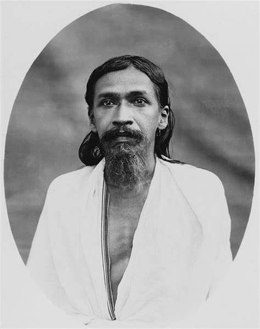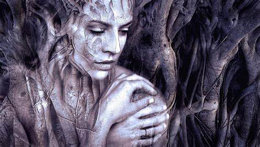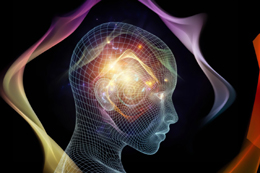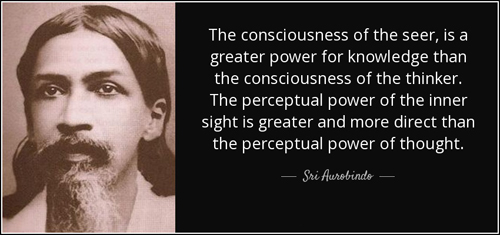Mental health
Consciousness: An Expanding Experiential Construct
Abstract
Sri Aurobindo’s vision of Consciousness is simultaneously pluri-dimensional and integral and it integrates the scientific and mystical paradigms though they are based on different standpoints. By validating the Individual as much as the Transcendent and by providing a comprehensive structural map of the Being that traverses both the heights and depths of Consciousness, a foundation for a futuristic psychology is being laid.
It is customary for neurosciences to define consciousness as “a primary element in experience that cannot be defined in terms of anything else (1).” The term “experience” in science usually refers to our ordinary sensory, perceptual and cognitive experience. However, mystical and spiritual disciplines have developed supra-physical and supra-rational modes of experience that reveal aspects of consciousness which cannot usually be discernible in perceptual-cognitive-ratiocinative terms.
Thus consciousness becomes an expanding experiential construct whose range increases as one traverses deeper and higher levels of Reality. As one progressively unravels newer spiritual experiences, one gains unique mystical and even occult insights. An integral paradigm of consciousness cannot reject one mode of experience in favour of another. Rather, different modes of experience have to be integrated along different levels of a spectral perspective.
The first question that arises when we attempt to integrate different modes of experience is, do they refer to the same thing? Thus mysticism deals with consciousness per se as a subjective experience that may or may not have objective validation while science deals with the phenomena of consciousness that are primarily objective, though a subjective element cannot be ruled out (a reason why even physics has to deal with the observer bias). This difference between mystical and scientific disciplines needs to be maintained as scientific parameters can only deal with phenomena which can be rationally, objectively, systematically and rigorously studied under the “experiment – observation – inference – verification – re-verification” rubric. Mysticism uses intuitive approaches and can deal with consciousness as a Reality or essence of existence that can be experientially perceived regardless of whether it fulfils the criteria of scientific objectivity.
Problems arise because though the scientific and mystical paradigms refer to two different perspectives, we use the same word “consciousness”, albeit interchangeably. Things get worse when a discipline like transpersonal psychology attempts to give equal importance to the mindsets of the scientist and the mystic. Perhaps the confusion would be less if two separate terms were used for the two paradigms. When spiritual experience describes consciousness as Reality or the essence of Reality, then the term “consciousness” is better represented in its purity and primordial state by the Sanskrit term, Chit or Cit or Citta, which is different from the phenomena which science studies as consciousness.
It is interesting to note that many Sanskrit terms cannot be easily translated into other languages or interposed into modern thought-paradigms without loss of meaning. It is traditionally held that the primordial vibrations comprise all reality and Sanskrit alphabets were derived from these reverberations so that meanings are associated with sounds in a significant way. In this view, every object starts as a vibration that holds the potential of the object as well as its corresponding sound. The vibration manifests as sound and following this trajectory, the sound manifests further to become the meaning-sound pair. Thus every object carries its name as an in-built programme that can be assessed in terms of consciousness (2). This is how practical taxonomies of the physical world were built with intricacy and sophistication in ancient India. It is in this context that the Sanskrit term Chit, Cit or Citta should be construed to signify consciousness in its essential and primordial mode.
Chit has been viewed as “pure consciousness” or “divine consciousness” in contrast to the ordinary mental or phenomenal consciousness (3). Sri Aurobindo describes that it is “the universal conscious-stuff of existence” that can remain unmanifest or get manifested in many poises (4). There is the poise of the mental self-awareness in human beings where the universality of Chit gets limited; there is the poise of a still limited consciousness in terrestrial forms below the level of human beings in the scale of evolution while at the level of matter, Chit gets so limited that it appears to be inconscient. There are also superhuman poises where Chit can manifest with greater potentialities than in ordinary mentality. Finally, there is the transcendental poise of Chit which is a state of “pure consciousness” without any phenomenal content.
For a scientist, an exploration of consciousness studies would be meaningless in the absence of phenomenology. For a mystic, an exploration of realms of consciousness without any phenomenon may provide the ultimate meaning of Reality or may demonstrate how a phenomenal world is supported by a non-phenomenal dimension of consciousness. In fact, Chit is “the elemental origin and primal completeness” of all the varied forms and phenomena and poises through which consciousness is manifested (5), as well as that indescribable state where all phenomenal attributes are transcended.
While mystics tend to study consciousness in its pure, divine, Chit aspect without phenomenal attributes or supporting phenomenal contents, scientists study consciousness exclusively through diverse physical and psychological phenomena. Sri Aurobindo uses the term consciousness in the broadest possible sense so that it signifies all the possible poises through which consciousness is manifested. From the spiritual perspective, such as usage of the term consciousness is justified because of two reasons:
1. Firstly, spiritual experience has identified Consciousness with Existence (Sat),“All is Chit because all is Sat... (6)”and;
2. Secondly, all phenomena which science studies as attributes of consciousness are viewed as restricted and limited forms, modes and movements of the pure, divine Chit. “These lower modes of consciousness are the conscious-stuff of inferior planes in one indivisible existence”.... “It is this Chit which modifies itself so as to become ..... on the mental plane the mental reason, will, emotion, sensation, on the lower planes the vital or physical instincts, impulses, habits of an obscure force not in superficially conscious possession of itself (7).”
Sri Aurobindo’s usage of the term consciousness is not only limited to the poises through which consciousness is manifest — it extends to those states where consciousness is unmanifest. This includes at one end, the Inconscience where consciousness is not manifest and there is only a material energy which seems to work apparently through necessity or a self-regulating chance; while at the other end this usage also refers to experiential states of Void or Zero (or Asat, Non-Being Beyond, Non-Existence) where a term like Chit cannot be applied in the ordinary cognitive sense because “all terms are annulled and all cognitive experience is overpassed (8).”
Yet this Zero or Non-Existence is actually not devoid of consciousness because it is not “Nothing” but “something beyond the last term to which we can reduce our purest conception and our most abstract or subtle experience..... This Nothing then is merely a something beyond positive conception (9).” It appears to the mind as blank because the mind grasps only finite constructions. Even without transcending the ordinary cognitive level, there might be psychological processes without any apparent conscious contents representing a “cognitive unconscious (10).”
Likewise, the mechanical energy that characterises the Inconscience may actually be supported by a consciousness behind that cannot be cognised because of being masked. Thus Sri Aurobindo’s usage of the term consciousness spans both the Inconscient and the Superconscient. Moreover, Sri Aurobindo does not view consciousness only in individual terms but also in universal and transcendental terms.
It is important to understand that Sri Aurobindo views consciousness as an all-encompassing construct. We ordinarily link consciousness with ‘mind’ as this seems to be the highest faculty that has manifested in nature. That is why the Buddha said, “Mind is the first of all principles, Mind is the highest of all principles: indeed Mind is the constituent of all principles — manopuvvangamadhamma (11).” This ‘Mind’ is a status of consciousness that is manifested in individual as well as universal terms.
However, Sri Aurobindo considers the Mind as an intermediary plane of consciousness in the dynamic scale of evolution and hence transitional. Consciousness is not thus limited to the Mind but extends and expands beyond it. This is a concept that has to be appreciated in its proper perspective. Spiritual seekers have recorded the attainment of a static status beyond Mind described in various ways — Spirit, Ātman, Brahman, Sachchidānanda, One without a second, Zero without a first. The attainment of such a static status involves a withdrawal from the dynamic cycle of evolution and a surpassing or denial of all cognitive schemata. Sri Aurobindo acknowledges the validity of these realisations. Indeed these beyond-cognitive realisations, which usually are attained by seekers as crowning movements of their spiritual pursuit, were experienced by Sri Aurobindo at the very beginning of his spiritual odyssey before he formulated his own vision of the Truth.
When Sri Aurobindo speaks of the ‘Mind’ as transitional in nature, he is referring to the dynamics of the evolutionary hierarchy of consciousness that has the potentiality to manifest supra-cognitive states through a superior type of humanity. The traditional spiritual seekers described beyond-cognitive realisations which necessitate a state of ‘liberation’ from Nature. Psychology has a limited role in such an endeavour where cognition and hence the mind have to be surpassed, negated and denied.
Sri Aurobindo describes supra-cognitive states in a superior type of humanity that involves an evolution of cognitive consciousness through a “transformation” of Nature. This needs a new, albeit a greater psychology that encompasses consciousness in all its dimensions. “To do this we must dare to go below the clear surfaces of things on which the mind loves to dwell, to tempt the vast and obscure, to penetrate the unfathomable depths of consciousness and identify ourselves with states of being that are not our own. Human language is a poor help in such a search, but at least we may find in it some symbols and figures, return with some just expressible hints which will help the light of the soul and throw upon the mind some reflection of the ineffable design (12).”
Relevance to Psychology
Can the consciousness paradigm be used to construct a foundation for psychology that would provide a framework for constructing the structure of the being and which would help us to understand the appearance of psychopathology at different planes of consciousness, leading to concomitant therapeutic interventions at different levels?
If we consider consciousness only from the mystical perspective in its purity or Chit aspect that surpasses all cognitive phenomena, we reach the Transcendence. That would be the domain of spirituality where the individual would not matter, personality would be replaced by impersonality and psychology would no longer be relevant as the individuality, sustained by the ego would have to be transcended.
If we consider only the scientific paradigm of consciousness that arises from the Matter-Energy interface, then we would lack a metaphysical support for psychology and thus miss the meaning of life. In fact today, meaninglessness per se has become a significant index for existential crisis.
Sri Aurobindo’s vision of consciousness incorporates simultaneously the mystical and scientific paradigms and surpasses both. There are unique characteristics in his vision which makes consciousness the Alpha and Omega of a futuristic psychology (13).
The first significant characteristic is that Consciousness as Reality is simultaneously present in three poises: the Transcendent, the Universal and the Individual. In many traditions, the Transcendence is considered to be God while the rest are subsidiaries. In the Indian tradition, the Individual soul was recognised but was ultimately believed to dissolve, disappear or merge into the Absolute. The individual was thus an ephemeral being destined to be absorbed into the great Void. Only Sri Aurobindo gives the Individual a poise that is similar in stature to the Transcendental and Universal and therefore imparts a legacy of permanence. This imparts a spiritual validity to psychology. It also permits the consideration of different denouements of immortality.
The second important characteristic is that Consciousness is not only pluri-dimensional but simultaneously integral. If this element of integrality was not there, we would have discrete planes of consciousness, whose shifting strands would not have facilitated the emergence of a being. The concept of integrality is complex and has to be understood at different perspectives. Each new plane of consciousness that manifests integrates the preceding plane and carries the potentiality of the anterior planes. This is an integration that occurs along the trajectory of the evolution of Consciousness.
There is another integration that makes the manifestation viable. Ordinarily the surface personality of an individual is a chaotic mixture of interspersed planes that revolve around the ego. As one surpasses the ego, the different planes can be disentangled from one another and integrated around a fourth-dimensional ego-surpassing principle. Such an integrated being can now be ready to traverse the higher ranges of Consciousness.
The third significant characteristic is that Consciousness itself has anin-built evolutionary schemata more fundamental than the biological evolution of forms. However these schemata do not arise from a vacuum, though outwardly they seem to arise from the Inconscience. Consciousness researchers are baffled as to how qualia can emerge from the non-qualia of Inconscience. Sri Aurobindo explains that the Inconscience is phenomenal and not fundamental. Whatever evolves is at first involved in the Inconscience. The Superconscient descends through a complex process of involution and turns into opposite values in the Inconscience. What was Truth, Light, Knowledge, Life, Love and Joy turn into Falsehood, Darkness, Ignorance, Death, Hatred and Suffering! This is the primal origin of falsehood, suffering, ignorance and death. It is from this matrix of negativity that evolution starts. Initially the being needs a temporary scaffolding to rise from a resistant milieu which becomes the ego-entity.
The fourth significant characteristic is that Consciousness not only formulates the evolutionary worlds but also non-evolutionary worlds or typal worlds. These typal worlds are constructed during the process of involution or descent of the Superconscious to the Inconscience that preceded the evolution of consciousness. Every plane of consciousness that manifests during evolution has a corresponding non-evolutionary plane. In fact, during evolution, there are two propelling forces. One is the evolutionary nisus that presses from below and the other is the projecting force from the corresponding non-evolutionary plane. The higher typal or non-evolutionary worlds are domains of constructive forces while the lower typal worlds are domains of disruptive or hostile forces. The human being is actually influenced by the interplay of evolutionary and non-evolutionary forces but this is a subject that is not understood outside occult disciplines. It is high time that a futuristic psychology removes its conventional biases and explores this fascinating domain of consciousness without which our understanding of reality is incomplete.
The fifth significant characteristic is that Consciousness outlasts the lifespan of an individual. It is true that evolution starts from the Inconscience where all the Superconscient values are represented in their opposite terms. Yet the decree for the evolution to commence was carried by a soul-spark that was a delegate of the Supreme Reality. This soul-spark grows through many life-times, accruing experiences till it becomes a soul-personality or psychic being,that at an opportune time can come forward to take over the functions of the ego.
The psychic being is a fourth-dimensional ego-surpassing principle around which the different planes of consciousness can be integrated. It carries the most intense, sweetest or deepest experiences of a lifetime, especially experiences which have a divine connotation. These experiences survive as memory transcripts in the cosmic consciousness beyond the lifespan of individuals and can influence future lives in diverse ways.
The sixth significant characteristic is that Sri Aurobindo’s vision of Consciousness provides the most comprehensive structural map of the Being that accommodates both the dimensions of personality and impersonality. It places the human being simultaneously along a vertical perspective and a horizontal perspective. The vertical perspective spans from the Inconscience to the Superconscience and traverses the planes of the physical, vital and mental consciousness and even supra-cognitive planes. The horizontal perspective extends from the ego-bound outer being, crosses an inneror subliminal being that is in communion with the cosmic consciousness to reach the soul-space. This soul-space holds the Central Being or Jivatman or Unevolving Self that supports the manifestation though not located within it but sends or projects an evolving mode into the manifestation which is the psychic being. The psychic being can come forward to replace the ego which is skewed in functioning and harmonise the disparate aspects of the being into an integral whole.
In his comprehensive vision of Consciousness, Sri Aurobindo integrates the mystical and scientific perspectives of consciousness in a unique and meaningful way.
References
1. Ross MN (ed. Walton J). Brain’s Diseases of the Nervous System. 10th ed. Oxford: Oxford University Press; 1993, p. 134.
2. Malhotra R. Being Different. An Indian Challenge to Western Universalism. India: Harper Collins; 2011, pp. 222-25.3. Sri Aurobindo. The Complete Works of Sri Aurobindo, Volume 23. Sri Aurobindo Ashram Trust; 1999, p. 387.
4. Ibid., p.388.
5. Ibid., p. 389.
6. Ibid.
7. Ibid.
8. Sri Aurobindo. CWSA, Volume 21; 2005. p. 54.9. Ibid., p. 32.
10. Velmans M. Understanding Consciousness. London: Routledge; 2000, p.16.
11. Gupta, Nolini Kanta. Collected Works. 3rd ed. Kolkata: Sri Aurobindo Bhavan; 1989, p. 9.
12. Sri Aurobindo. CWSA, Volume 21; 2005, p. 55.
13. Basu S, Miovic, M. Consciousness Based Psychology: Sri Aurobindo’s Vision of Yoga, Health and Transpersonal Growth (at the press).
Dr. Soumitra Basu, a practising psychiatrist and member of SAIIIHR, is the Director of a school of psychology, Integral Yoga Psychology. He is also one of the editors of NAMAH.
Share with us (Comments,contributions,opinions)
When reproducing this feature, please credit NAMAH,and give the byline. Please send us cuttings.









